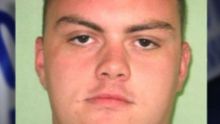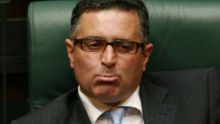Sixty radioactive cow carcasses are buried beneath land in Werribee that the Andrews government is trying to sell to a Chinese consortium keen to build a $20-billion education precinct in Melbourne's west.
Documents obtained by Fairfax Media estimate the cost of cleaning up the radioactive waste could reach $300 million, with a further $770 million required to remove thousands more cow carcasses that are considered a biological hazard. Even conservative estimates put the cost of the clean up at $35 million.
More Victoria News Videos
Radioactive cows buried at Werribee development site
Fairfax Media can reveal the site of proposed 100,000 people strong satellite city near Werribee has 60 radioactive cow carcasses buried just beneath the surface.
Investors Direct is the exclusive bidder on the 775-hectare site, which includes parts of the old State Research Farm, laboratories and veterinary schools, where scientific testing on animals was conducted for decades.
The consortium, which has former Victorian premier John Brumby as an adviser, plans to build Australian Education City – a precinct that will be home to 80,000 residents and 50,000 students – on land that adjoins the site of the planned new Youth Detention Centre.

Fairfax Media can reveal the Victorian state government and VicUrban were told that radioactive cow carcasses were buried on four hectares of land in Werribee in early 2009, when Mr Brumby was premier. Another burial pit, which contains the remains of non-radioactive cows, is located on the site of the planned detention centre.
Coffey Environment completed a phase 1 environmental assessment report on the Werribee site in March 2009. The report found that "animals that have been subjected to testing with radioactive tracer dyes" were buried at the site. The report lists the cow carcasses as a "possible biological and radiological hazard" and says the contamination could impact both soil and groundwater.
The report states that "the tracer dye used was predominantly tritium" which "has a half-life of approximately 12 years". The report adds that "these practices were understood to have ceased at the site in the mid 1990s".
The state government has told Fairfax Media that a recent study has indicated no radioactive material has polluted soil or groundwater on the property, but that report is yet to be made public.

Minimal work was done to dispose of the radioactive cow carcasses. "Burial involved excavation of a hole or trench several metres deep, placement of the carcasses and capping with site-derived clay soils of at least one metre thickness," the report states.
As it decays, tritium releases radioactive isotopes that, according to overseas reports, can be dangerous to human health for approximately 120 years.

In July 2010, Coffey Environments provided high-level advice to the then department of planning and community development. That advice identified 42 areas of potential environmental contamination caused by pesticides and herbicides, buried farm waste, sheep dipping facilities, buried carcasses and radioactive carcasses.
The 2010 report states the likelihood of radioactive material being present on the site is "high", and "may introduce chemical, biological or radioactive contamination to soil and groundwater".

A former minister in the Brumby government said he had no knowledge of the report. "Radioactive zombie cows in Werribee? You are pulling my leg, aren't you?" the former minister said.
The burial of radioactive cows was confirmed by the Department of Primary Industries (DPI), which has not revealed why the cows were treated with radioactive tritium dyes. The DPI has, however, "indicated historic burial of potentially radioactive carcasses" over a number of zones within the greenfield site.

Radioactive isotopes can enter the human body via food that has been grown in contaminated soil. Just to the south of the contaminated site are many of Werribee's market gardens.
According to the environmental report, in a worst-case scenario, "some radioactive isotopes may have entered surface water or groundwater", in which case up to 130,000 cubic metres of contaminated soil would have to be excavated, and disposed of off-site.

That is the equivalent of 8125 standard dump truck loads of radioactive material travelling through Melbourne's western suburbs, and would add $770 million to the clean-up bill, taking the total cost to $1.07 billion.
The report notes that the burial pits are "unsuitable to remain within the developed site beneath structures or anywhere within sites used for sensitive uses". One of areas used to bury animal carcasses is now the site of a student residence.

In addition, an open drainage channel passes directly through the location where radioactive cow carcasses were buried. That channel flows towards Hoppers Crossing.
In addition, no signs are placed to warn that dangerous radioactive material may be present on radioactive site, which backs on to Suzanne Cory High School.
A spokesman for the state government told Fairfax Media it was now in contact with the Environmental Protection Agency, almost eight years after the initial report into the hazardous pollution.
"Ongoing discussions continue with EPA and the environmental consultants about how best to deal with the material, potentially onsite containment or offsite treatment and disposal," the spokesman said. "Recent and extensive testing of the site has been conducted as part of phase 2 due diligence confirmed that there is no risk to residents or groundwater.":
Negotiations between the state government and the Australian Education City bid are said to be "advanced", with a decision on the site originally scheduled for February 15.
The Investors Direct consortium is led by former Price Waterhouse Cooper executive Bill Zheng, and has the backing of Chinese institutional and corporate investors.
Ross Martiensen, executive director with Australian Education City, declined to comment when contacted by Fairfax Media.
Twitter: @HawthorneMark












